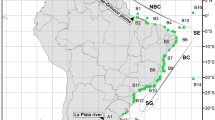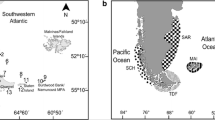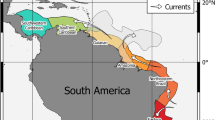Abstract
The Antarctic shelf fauna is isolated from other continental shelf faunas both physically by distance, and oceanographically by the Antarctic circumpolar current (ACC). To elucidate the relative importance of these two isolating mechanisms, we used the seastar fauna of the south-Atlantic sub-Antarctic islands to address the hypothesis that the ACC is dominant in controlling the distribution pattern of Antarctic fauna. We expected that seastar faunas from islands on the high latitude side of the ACC would show more similarities to each other than to faunas from islands on the low latitude side. The alternative isolation by distance model predicted that the island furthest from others would have the most unique fauna. For shelf-depth (<500 m) Asteroidea of the Scotia Arc region, assemblages were more similar between islands on each side of the ACC barrier than islands that were closer together, and this pattern was caused by differences in abundance of a few ubiquitous species.




Similar content being viewed by others
References
Anderson JB (1999) Antarctic marine geology. Cambridge University Press, New York, p 289
Arnaud PM (1977) Adaptations within the antarctic marine benthic ecosystem. In: Llano GA (ed) Adaptations within Antarctic ecosystems. Proceedings of the Third SCAR Symposium on Antarctic Biology. Smithsonian Institution, Washington, pp 135–157
Arntz WE, Brey T, Gallardo VA (1994) Antarctic zoobenthos. Oceanogr Mar Biol Ann Rev 32:241–304
Arntz WE, Gutt J, Klages M (1997) Antarctic marine biodiversity. In: Battaglia B, Valencia J, Walton DHW (eds) Antarctic communities: species, structure and survival. Cambridge University Press, Cambridge, pp 3–14
Arntz WE, Thatje S, Gerdes D, Gili JM, Gutt J, Jacob U, Montiel A, Orejas C, Teixido N (2005) The Magellan-Antarctic connection: macrobenthos ecology on the shelf and upper slope, a progress report (Proceedings of the Second International IBMANT Conference, CADIC, Ushuaia, Argentina, 19–24 Oct 2003). Sci Mar 69(2):237–269
Arntz WE, Thatje S, Linse K, Avila C, Ballesteros M, Barnes DKA, Cope T, Cristobo FJ, de Broyer C, Gutt J, Isla E, López-González P, Montiel A, Munilla T, Ramos Esplá AA, Raupach M, Rauschert M, Rodríguez E, Teixidó N (2006) Missing link in the Southern Ocean: sampling the marine benthic fauna of remote Bouvet Island. Polar Biol 29(2):83–96
Aronson RB, Blake DB (2001) Global climate change and the origin of modern benthic communities in Antarctica. Am Zool 41(1):27–39
Bargelloni L, Zane L, Derome N, Lecointre G, Patarnello T (2000) Molecular zoogeography of Antarctic euphausiids and notothenioids: from species phylogenies to intraspecific patterns of genetic variation. Antarctic Sci 12(3):259–268
Barker PF, Thomas E (2004) Origin, signature and palaeoclimatic influence of the Antarctic circumpolar current. Earth Sci Rev 66:143–162
Barnes DKA (2006) A most isolated benthos: coastal bryozoans of Bouvet Island. Polar Biol 29(2):114–119
Barnes DKA, De Grave S (2001) Ecological biogeography of southern polar encrusting faunas. J Biogeogr 28(3):359
Barnes DKA, Hodgson DA, Convey P, Allen CS, Clarke A (2006) Incursion and excursion of Antarctic biota: past, present and future. Global Ecol Biogeogr 15(2):121
Berkman PA, Tipton-Everett LR (eds) (2001) Latitudinal Ecosystem (LAT-ECO) Responses to climate across Victoria Land, Antarctica. Report of a National Science Foundation Workshop. Byrd Polar Research Center Report #20. The Ohio State University, Columbus, p 152
Bockus D (1999) Anchor ice disturbance in McMurdo Sound, Antarctica and the structure of benthic infaunal communities. MS Thesis, CSU Stanislaus/MLML, p 54
Bosch I, Pearse JS (1990) Developmental types of shallow-water asteroids of McMurdo Sound, Antarctica. Mar Biol 104(1):41–46
Branch GM, Attwood CG, Gianakouras D, Branch ML (1993) Patterns in the benthic communities on the shelf of the sub-Antarctic Prince Edward Islands. Polar Biol 13(1):23–34
Clark AM (1962) Asteroidea. British-Australian-New Zealand Antarctic Research Expedition 1929–1931. Report Series B 9:1–104
Clark HES (1963) The fauna of the Ross Sea. Part III. Asteroidea. Bull NZ Dep Scient Ind Res 151:9–84
Clarke A (1983) Life in cold water: the physiological ecology of polar marine ectotherms. Oceanogr Mar Biol Ann Rev 21:341–453
Clarke A (1996) Marine benthic populations in Antarctica: patterns and processes. In: Ross RM, Hofmann EE, Quetin LB (eds) Foundations for ecological research West of the Antarctic Peninsula. Antarct Res Book Ser 70:373–388
Clarke A (2003) The polar deep sea. In: Tyler PA (ed.) The deep seafloor. Goodall DW (ed in chief) Ecosystems of the world. Elsevier, Amsterdam, pp 239–260
Clarke A, Barnes DKA, Hodgson DA (2005) How isolated is Antarctica? Trends Ecol Evol 20:1–3
Clarke A, Crame JA (1989) The origin of the Southern Ocean marine fauna. In: Crame JA (ed) Origins and evolution of the Antarctic biota. Geological Society special publication no. 47. Geological Society of London, London, pp 253–268
Clarke A, Johnston NM (2003) Antarctic marine benthic diversity. Oceanogr Mar Biol 41:47–114
Clarke KR, Warwick RM (2001) Change in marine communities: an approach to statistical analysis and interpretation. PRIMER-E, Plymouth, p 172
Crame JA (1999) An evolutionary perspective on marine faunal connections between southernmost South America and Antarctica. Sci Mar 63(1):1–14
Dawson EW (1970) Faunal relationships between the New Zealand plateau and the New Zealand sector of Antarctica based on echinoderm distribution. NZ J Mar Freshwat Res 4:126–40
Dayton PK, Robilliard GA, Paine RT (1970) Benthic faunal zonation as a result of anchor ice at McMurdo Sound, Antarctica. In: Holdgate MW (ed) Antarctic ecology vol I. Academic, London, pp 244–258
Dayton PK, Robilliard GA, Paine RT, Dayton LB (1974) Biological accommodation in the benthic community at McMurdo Sound, Antarctica. Ecol Monogr 44(1):105–128
Dayton PK, Mordida BJ, Bacon F (1992) Polar marine communities. Am Zool 34(1):90–99
De Freitas JC (1982) Diplasterias brandtii (Bell, 1881) a cryophile starfish from the northern littoral of Sao Paulo. Cienc Cult 34(8):1058–1059
Deacon GER (1933) A general account of the hydrology of the South Atlantic Ocean. Discov Rep VII:177–238
Dearborn JH, Edwards KC, Fratt DB (1991) Diet, feeding behavior, and surface morphology of the multi-armed Antarctic sea star Labidiaster annulatus (Echinodermata: Asteroidea). Mar Ecol Prog Ser 77(1):65–84
Dell RK (1972) Antarctic benthos. Adv Mar Biol 10:1–216
Eastman JT, McCune AR (2000) Fishes on the Antarctic continental shelf: evolution of a marine species flock? J Fish Biol 57:84–102
El-Sayed SZ (1985) Plankton of the Antarctic seas. In: Bonner WN, Walton DWH (eds) Key environments of Antarctica. Pergamon, Oxford, pp 135–153
Gutt J, Starmans A (2001) Quantification of iceberg impact and benthic recolonisation patterns in the Weddell Sea (Antarctica). Polar Biol 24(8):615–619
Gutt J, Fricke A, Teixidó N, Potthoff M, Arntz WE (2006) Mega-epibenthos at Bouvet Island (South Atlantic): a spatially isolated biodiversity hot spot on a tiny geological spot. Polar Biol 29(2):97–105
Hammond PM (1994) Practical approaches to the estimation of the extent of biodiversity in speciose groups. Philos Trans: Biol Sci 345(1311):119–136
Hempel G (1985) On the biology of polar seas, particularly the Southern Ocean. In: Gray JS, Christiansen ME (eds) Marine biology of polar regions and effects of stress on marine organisms. Wiley, Chichester, pp 3–33
Holdgate MW (1960) The Fauna of the Mid-Atlantic Islands. Proc R Soc Lond Ser B Biol Sci 152(949). A discussion on the biology of the southern cold temperate zone, pp 550–567
Knox GA (1970) Antarctic marine ecosystems. In: Holdgate MW (eds) Antarctic ecology. Academic, London, pp 69–96
Lambert G (2005) Ecology and natural history of the protochordates. Can J Zool 83(1):34–50
Lawver LA, Gahagan LM, Coffin MF (1992) The development of paleoseaways around Antarctica. In: Kennett JP, Warnke DA (eds) The Antarctic paleoenvironment: a perspective on Global change, Part 1. Antarctic Res Ser 56. American Geophysical Union, Washington, pp 7–30
Lewis PN, Riddle MJ, Smith SDA (2005) Assisted passage or passive drift: a comparison of alternative transport mechanisms for non-indigenous coastal species into the Southern Ocean. Antarct Sci 17:183–191
Maldonado M, Bergquist PR (2002) Phylum Porifera. In: Young CM (eds) Atlas of marine invertebrate larvae. Academic, San Diego, pp 21–50
McClintock JB (1994) Trophic biology of Antarctic shallow-water echinoderms. Mar Ecol Prog Ser 111(1–2):191–202
McClintock JB, Amsler CD, Baker BJ, van Soest RWM (2005) Ecology of Antarctic marine sponges: an overview. Integr Comp Biol 45(2):359–368
Mincks SL, Smith CR, DeMaster DJ (2005) Persistence of labile organic matter and microbial biomass in Antarctic shelf sediments: evidence of a sediment “food bank”. Mar Ecol Prog Ser 300:3–19
Moore JK, Abbott MR, Richman JG (1999) Location and dynamics of the Antarctic Polar Front from satellite sea surface temperature data. J Geophys Res 104(C2):3059–3073
Norkko A, Andrew N, Thrush S, Cummings V, Schwartz AM, Hawes I, Mercer S, Budd R, Gibbs M, Funnell G, Hewitt G, Goring D (2002) Ecology and biodiversity of coastal benthic communities in McMurdo Sound, Ross Sea: development of sampling protocols and initial results. Final Res Rep NZ Minist Fish Res Project ZBD2001/02
Osorio RC, San-Martin A (1985) Displasterias brucei (Kohler 1908), an incubator asteroid from elephant Island, Chilean Antarctica. Serie cientifica, Instituto Antartico chileno, Santiago 32:99–102
Page TJ, Linse K (2002) More evidence of speciation and dispersal across the Antarctic Polar Front through molecular systematics of Southern Ocean Limatula (Bivalvia: Limidae). Polar Biol 25(11):818–826
Pearse JS, Bosch I (1986) Are the feeding larvae of the commonest Antarctic asteroid really demersal? Bull Mar Sci 39:477–484
Pearse JS, McClintock JB, Bosch I (1991) Reproduction of Antarctic benthic marine invertebrates: tempos, modes and timing. Am Zool 31:65–80
Peek AS, Feldman RA, Lutz RA, Vrijenhoek RC (1998) Cospeciation of chemoautotrophic bacteria and deep sea clams. Evolution 95(17):9962–9966
Picken GB (1985) Marine habitats—benthos. In: Bonner WN, Walton DWH (eds) Key environments—Antarctica. Pergamon, Oxford, pp 154–172
Piepenburg D, Voss J, Gutt J (1997) Assemblages of sea stars (Echinodermata: Asteroidea) and brittle stars (Echinodermata: Ophiuroidea) in the Weddell Sea (Antarctica) and off Northeast Greenland (Arctic): a comparison of diversity and abundance. Polar Biol 17(4):305–322
Poulin E, Palma AT, Féral JP (2002) Evolutionary versus ecological success in Antarctic benthic invertebrates. Trends Ecol Evol 17(5):218–222
Prothero DR (1994) The eocene–oligocene transition: paradise lost. Columbia University Press, New York
Ragua-Gil JM, Gutt J, Clarke A, Arntz WE (2004) Antarctic shallow-water mega-epibenthos: shaped by circumpolar dispersion or local conditions? Mar Biol 144(5):829–839
Ramos A (1999) The megazoobenthos of the Scotia Arc islands. Magellan-Antarctic: ecosystems that drifted apart. Sci Mar 63(1):171–182
Ríos C, Mutschke E, Morrison E (2003) Biodiversidad bentónica sublitoral en el estrecho de Magallanes, Chile. Revista Biología Marina Oceanografía 38(1):1–12
Schlüter M, Rachor E (2001) Meroplankton distribution in the central Barents Sea in relation to local oceanographic patterns. Polar Biol 24(8):582–592
Shaw PW, Arkhipkin AI, Al-Khairulla H (2004) Genetic structuring of Patagonian toothfish populations in the Southwest Atlantic Ocean: the effect of the Antarctic polar front and deep-water troughs as barriers to genetic exchange. Mol Ecol 13(11):3293
Slattery M, Bosch I (1993) Costs of brood maintenance and development in the seastar Neosmilaster georgianus from Anvers Island, Antarctica. Antarct J US 2(5):136–138
Sneath PHA, Sokal RR (1973) Numerical taxonomy—the principles practice of numerical classification. W.H. Freeman, San Francisco
Somero GN, Fields PA, Hofmann GE, Weinstein RB, Kawall H (1998) Cold adaptation and stenothermy in Antarctic notothenioid fishes: what has been gained and what has been lost? In: Di Prisco G, Pisano E, Clarke A (eds) Fishes of Antarctica: a biological overview. Springer Italia, Milano, pp 97–109
Starmans A, Gutt J (2002) Mega-epibenthic diversity: a polar comparison. Mar Ecol Prog Ser 225:45–52
Starmans A, Gutt J, Arntz WE (1999) Mega-epibenthic communities in Arctic and Antarctic shelf areas. Mar Biol 135(2):269–280
Teixido N, Garrabou J, Arntz WE (2002) Spatial pattern quantification of Antarctic benthic communities using landscape indices. Mar Ecol Prog Ser 242:1–14
Teixidó N, Garrabou J, Gutt J, Arntz WE (2004) Recovery in Antarctic benthos after iceberg disturbance: trends in benthic composition, abundance and growth forms. Mar Ecol Prog Ser 278:1–16
Thatje S, Mutschke E (1999) Distribution of abundance, biomass, production and productivity of macrozoobenthos in the sub-Antarctic Magellan province (South America). Polar Biol 22(1):31–37
Thatje S, Hillenbrand CD, Larter R (2005) On the origin of Antarctic marine benthic community structure. Trends Ecol Evol 20(10):534–540
Thrush SF, Dayton PK (2002) Disturbance to marine benthic habitats by trawling and dredging: implications for marine biodiversity. Annu Rev Ecol Syst 33:449–473
Thurber A (2005) Fatty acids and stable isotopes in Antarctic sponges: diet analysis of gutless animals. MS Thesis, Moss Landing Marine Laboratories, California State University, Stanislaus
Vacelet J, Boury-Esnault N (1995) Carnivorous sponges. Nature 373:333–335
White MG (1984) Marine benthos. In: Laws RM (ed) Antarctic ecology, vol. 2. Academic, London, pp 421–462
Acknowledgments
We would like to acknowledge the excellent support provided by RPSC personnel and the officers and crew of the RVIB Nathanial B. Palmer. We are very grateful to Bill Detrich and the ICEFISH 2004 cruise participants, especially Marino Vacchi, Federico Mazzei, Romolo Fochetti, Craig Marshall, Phil Ross and Shane Windsor for their assistance and companionship in the field. We thank Kamille Hammerstrom, Jim Oakden, and John Oliver for help, advice and encouragement. Jim McClintock and two anonymous reviewers improved the manuscript with their comments. This work was supported in part by National Science Foundation grants OPP-0126319 to Stacy L. Kim (Moss Landing Marine Laboratories) and OPP-0132032 to H. William Detrich (Northeastern University). This is publication number 16 from the ICEFISH 2004 cruise (H.W.D., Chief Scientist, RVIB Nathaniel B. Palmer). For more information, visit http://www.icefish.neu.edu.
Author information
Authors and Affiliations
Corresponding author
Rights and permissions
About this article
Cite this article
Kim, S., Thurber, A. Comparison of seastar (Asteroidea) fauna across island groups of the Scotia Arc. Polar Biol 30, 415–425 (2007). https://doi.org/10.1007/s00300-006-0198-2
Received:
Accepted:
Published:
Issue Date:
DOI: https://doi.org/10.1007/s00300-006-0198-2




